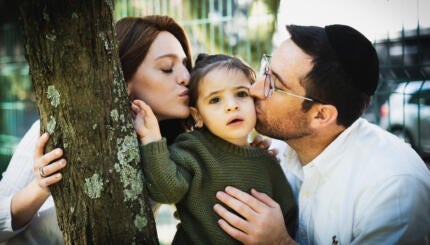In 1654, the first group of Jews arrived in colonial America. They were 23 Sephardic refugees who were fleeing Brazil, which had been recently captured by the Portuguese. Sometimes dubbed the “Jewish Pilgrim Fathers,” these Sephardic Jews docked in New Amsterdam (later New York), seeking permission to reside among the locals, and hoping to conduct trade.

The Christian colonials in America were not all pleased to welcome these Jews. Peter Stuyvesant, governor of New Amsterdam, tried to have the Jews expelled from the city. He was unsuccessful at that, but still Jews were limited in how they could participate in local trade. However, as the years went on and the Jews in America became more influential, they were accorded increasingly more rights.
Colonial Jews
Up until the American Revolution, adventurous Jewish merchants–both Sephardic and Ashkenazic–established homes in New Amsterdam and other American colonial ports, including Newport, Philadelphia, Charleston, and Savannah.
However, the earliest American Jewish communities all followed Sephardic customs; the rational and refined aesthetic of Sephardic practices appealed to Jewish colonials, Sephardic and Ashkenazic alike. The first American synagogue, Shearith Israel in New York, was completed in 1730. Until the early 19th century, this Sephardic synagogue made it mandatory for every Jew who arrived in the city to affiliate with and contribute to it.
At the time of the American Revolutionary War (1775-1783), the loyalties of Jewish colonials were divided, with a sizeable majority favoring the Patriot vision of an independent America. About 100 Jews fought in the war on both sides, and many more were driven from their homes because of British attacks.
With your help, My Jewish Learning can provide endless opportunities for learning, connection and discovery.
Post-Revolution
After American independence was declared in 1776, and the Constitution ratified in 1788, Jews were afforded what the historian of American Judaism Jonathan Sarna calls “an unprecedented degree of equal footing.” In a famous 1790 letter to the Jewish Congregation in Newport, George Washington reassured the Jewish community of its religious liberty, and even hinted that America might prove something of a Promised Land for Jews.
Many Jews from abroad arrived to make good on this promise. Between 1815 and the eve of the Civil War, two million German-speaking Europeans migrated to the United States, including thousands of Jews. With this second wave of immigration, the character of American Jewish practice shifted from Sephardic to Ashkenazic tradition.
European Immigration
German Jews came to America because it was a place of economic and social opportunity. Some of the more famous were Levi Strauss, who arrived in America in 1847, in time to exploit Gold Rush fever in California, and Joseph Seligman, who immigrated in 1837 and became an eminent investment banker.
Many German immigrants flocked to the Cincinnati area, which was considered a gateway to trade in the Midwest and West, and Cincinnati became the seat of American Reform Judaism.
Immigration slowed during the Civil War (1861-1865), which divided Jews as it did all Americans. Southern Jews supported the Confederacy; Northern Jews favored the Union. Jews fought on both sides in numbers greater than their percentage in the general population.
After the Civil War, German Jews continued to arrive in America, and beginning in the 1880s they were joined by large numbers of Jews from Eastern Europe. Once again, the character of American Jewry was transformed, as the Eastern Europeans became the majority.
Turn of the 20th Century
Pushed by increasing anti-Semitism at home and pulled by the economic and social promise of America, Eastern European Jewish immigrants were willing to work hard to succeed in America. They tended to live in densely-populated neighborhoods, most famously New York’s Lower East Side, and they established themselves in lines of work such as the garment industry.
Large numbers of immigrants labored in harsh, inhumane sweatshop conditions, and in response, the Jewish trade union movement emerged as a formidable force. Many Jewish workers supported socialism or communism as a means of securing economic and social equality, and their political organizing established a strong link between American Jews and American liberalism.
Religious life was complicated for Eastern European immigrants, who found themselves for the first time free to observe or neglect their religion. The three major Jewish denominations–Reform, Conservative, and Orthodox–crystallized at this time, each offering a different approach to the meaning of the Jewish religion in America.
Despite the growth of all three denominations, surveys from the early 20th century found that the number of “unsynagogued” Jews exceeded the number of “synagogued” ones by a wide margin. Even for those unaffiliated with a place of worship, Jewish charitable organizations constituted a pivotal axis for identification. Between 1895 and 1920 many of these bodies formed large “federations” which eventually became a crucial unifying force in the American Jewish community.
Sephardic
Pronounced: seh-FAR-dik, Origin: Hebrew, describing Jews descending from the Jews of Spain.


